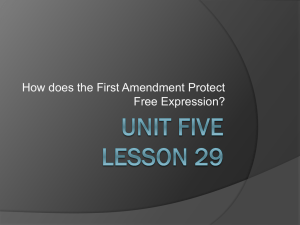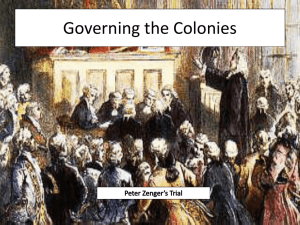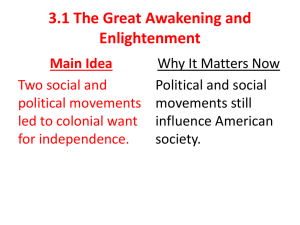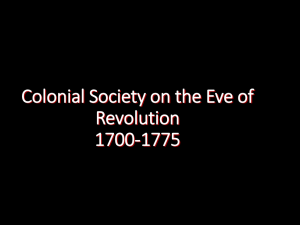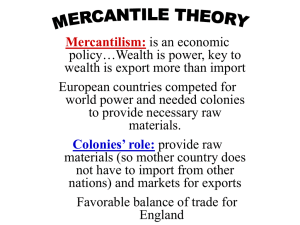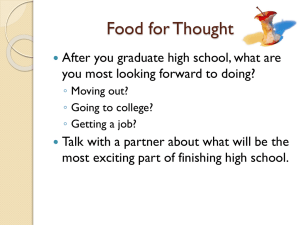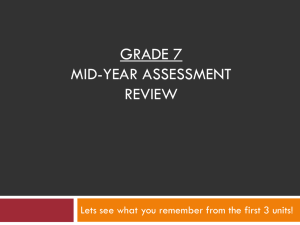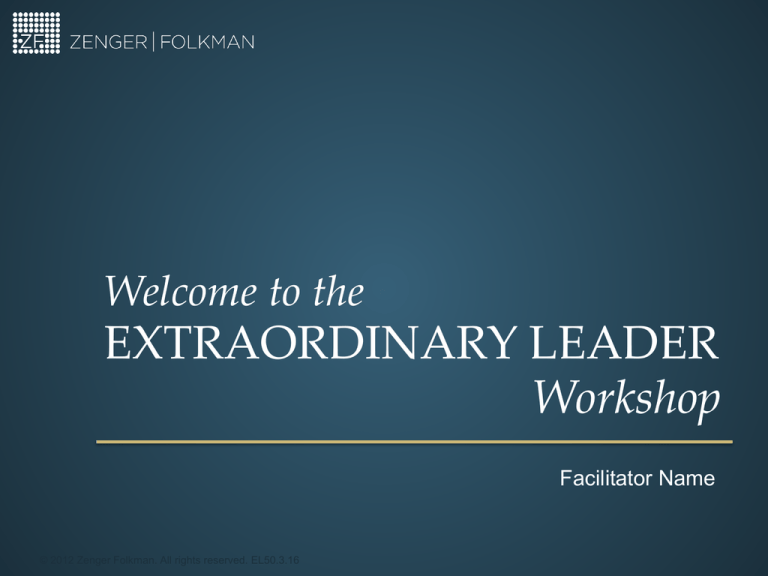
Welcome to the
EXTRAORDINARY LEADER
Workshop
Facilitator Name
© 2012 Zenger Folkman. All rights reserved. EL50.3.16
MAKING A DIFFERENCE
Module 1
© 2012 Zenger Folkman
2
The Research
• Two years researching the impact of
leadership performance and the key
behaviors exceptional leaders
demonstrate
• Data set of 200,000 evaluations on
20,000 people
• Contrasted the highest-performing 10%
to the lowest-performing 10%
• The approach: Lead with the data!
• The result: New insights that
fundamentally change the way we think
about leadership development
© 2012 Zenger Folkman
3
For a Full Report of the Research . . .
© 2012 Zenger Folkman
4
Workshop Objective
To help you create a
personal leadership
Development Plan
for becoming an
Extraordinary Leader
© 2012 Zenger Folkman
Page 1-2
5
Insight #1
Good does not equal great—
and your organization needs
you to be great
© 2012 Zenger Folkman
6
Turnover
Average Percent
Annual Turnover
Percentage
Leadership vs. Turnover
20
18
Extraordinary
leaders are
much better at
holding onto
their people
19
16
14
14
12
10
8
9
6
4
2
0
Bottom 30%
Poor Leaders
Middle 60%
Good Leaders
Top 10%
Great Leaders
Insurance Company Call Center
© 2012 Zenger Folkman
7
www.zengerfolkman.com
Leadership vs. Customer Satisfaction
Customer Satisfaction Percentile
65
60
60
57
55
49
50
46
45
40
36
35
30
Bottom 10
Percentile
Technology Service Provider
© 2012 Zenger Folkman
11th - 35th
36th - 65th
66th - 90th
Overall Leadership Effectiveness
Top 10
Percentile
Leadership vs. Net Income
$4.5MM
5000000
Net Income
4000000
Great leaders
generate much
higher income
$2.4MM
3000000
2000000
1000000
($1.2MM)
0
-1000000
-2000000
Bottom 10%
Poor Leaders
Middle 80%
Good Leaders
Top 10%
Great Leaders
Mortgage Bank Branches
© 2012 Zenger Folkman
9
Leadership Effectiveness vs. Employee Satisfaction/
Commitment
90
Employee Commitment/
Satisfaction Percentile
80
70
60
50
40
30
20
10
0
1st 9th
10th 19th
20th 29th
30th 39th
40th 49th
50th 59th
60th 69th
70th 79th
80th 89th
90th 100th
Leadership Effectiveness Percentile
30,661 Leaders Across Multiple Industries
© 2012 Zenger Folkman
Page 1-4
10
% of Employees Willing to Go Extra Mile
Leadership Effectiveness vs. Going the Extra Mile
60
50
40
30
20
10
0
1st 9th
10th 19th
20th 29th
30th 39th
40th 49th
50th 59th
60th 69th
70th 79th
80th 89th
90th 100th
Leadership Effectiveness Percentile
30,661 Leaders Across Multiple Industries
© 2012 Zenger Folkman
11
pl
ay
s
Hi
gh
Te
In
ch
te
So
gr
ni
ca
it y
lve
l
/P
an
s
ro
Pr
d
fe
H
ob
s
on
le
sio
es
m
na
s
ty
an
lE
d
xp
An
er
tis
al
yz
e
es
Pr
Is
su
ac
es
tic
es
In
Se
no
va
lf De
te
s
ve
lo
Dr
p
Es
ive
m
ta
en
s
bl
t
f
C
i
In
o
s
om
rR
he
sp
s
m
ire
es
St
un
ul
s
re
an
ts
ica
t
c
d
te
h
M
s
G
ot
Po
oa
Ta
iv
ls
w
ke
at
er
es
s
fu
I
n
O
lly
itia
th
an
er
tiv
s
d
e
Pr
to
ol
Hi
ific
gh
al
Pe
ly
Bu
r fo
ild
rm
s
an
Re
ce
la
tio
Co
ns
De
lla
hi
ve
bo
ps
lo
De
ra
p
t
s
io
ve
O
n
lo
th
an
ps
er
d
s
St
Co
Te
r
at
nn
am
e
ec
gi
wo
c
ts
Pe
rk
th
C
e
rs
ha
G
p
ec
ro
m
up
tiv
pi
o
e
ns
to
th
C
e
ha
O
ng
ut
e
si
de
W
or
ld
Di
s
What’s the Message From This Assessment?
Global Norm
© 2012 Zenger Folkman
Page 1-5
Richard
5
4.5
4
3.5
3
2.5
2
1.5
1
0.5
0
12
pl
ay
s
Hi
gh
Te
In
ch
te
gr
So
ni
it y
ca
lve
l
an
/P
s
r
d
Pr
of
H
es
ob
on
sio
le
es
m
n
ty
s
al
an
Ex
d
pe
An
r ti
al
se
yz
es
Is
Pr
su
ac
es
tic
es
In
no
Se
va
lf te
De
s
ve
lo
D
pm
Es
r iv
es
ta
en
bl
t
fo
Co
is
In
rR
he
sp
m
s
es
m
ire
St
un
ul
s
re
ts
ica
an
tc
d
h
te
M
G
s
ot
oa
Po
Ta
iv
ls
w
k
at
e
e
es
s
rfu
I
ni
lly
O
tia
th
an
er
tiv
d
s
e
Pr
to
ol
Hi
ific
gh
al
Pe
ly
r fo
Bu
rm
ild
s
an
Re
ce
la
t
i
o
Co
ns
De
lla
hi
ve
ps
bo
lo
De
ra
p
s
tio
ve
O
n
lo
th
an
ps
er
d
s
S
Co
Te
tr a
nn
am
te
ec
gi
wo
c
ts
Pe
rk
th
Ch
rs
e
p
G
am
ec
ro
tiv
pi
up
o
e
ns
to
th
C
ha
e
O
ng
ut
e
si
de
W
or
ld
Di
s
How’s Richard Doing Now?
90th Percentile Leaders
© 2012 Zenger Folkman
Richard
5
4.5
4
3.5
3
2.5
2
1.5
1
0.5
0
13
Exercise: Making a Difference
• In your experience, which goal do most leaders work
toward: to be “good enough” to get the job done, or to be
extraordinary? Which of the two has been your goal?
• If you could increase your leadership effectiveness from
good to great, what difference would it make to your
organization?
• If you could increase your leadership effectiveness from
good to great, what difference would it make to you
personally, in terms of your career opportunities and job
satisfaction?
© 2012 Zenger Folkman
Page 1-7
14
PROFOUND STRENGTHS
AND FATAL FLAWS
Module 2
© 2012 Zenger Folkman
Insight #2
You don’t have to
be perfect to be
an extraordinary
leader
© 2012 Zenger Folkman
16
What Does Performance Improvement Mean to Most People?
Fixing Weaknesses!
© 2012 Zenger Folkman
17
Impact of Leadership Effectiveness with No
Perceived Strengths
100
90
80
70
Average
60
Percentile
50
Score on
40
360 Results
30
20
10
0
34
0
1
2
3
4
5
Number of Profound Strengths
(Competencies at the 90th percentile)
© 2012 Zenger Folkman
Page 2-3
18
Impact of One Strength on Overall Perception of
Leadership Effectiveness
100
90
80
70
Average
60
Percentile
50
Score on
40
360 Results
30
20
10
0
64
34
0
1
2
3
4
5
Number of Profound Strengths
(Competencies at the 90th percentile)
© 2012 Zenger Folkman
Page 2-3
19
Three Strengths Raises Leadership Effectiveness to
the 81st Percentile
100
90
80
70
Average
60
Percentile
50
Score on
40
360 Results
30
20
10
0
89
91
4
5
81
72
64
34
0
1
2
3
Number of Profound Strengths
(Competencies at the 90th percentile)
© 2012 Zenger Folkman
Page 2-3
20
Focusing Development on Weaknesses Works Well When. . .
. . . People Have Fatal Flaws
A
B
D
E
F
G
Strong negative
data on an issue
can neutralize a
person’s
leadership
effectiveness
H
I
J
K
L
M
N
O
Overall Leadership Effectiveness
(Percentile)
Leadership Competencies
C
100
90
80
70
60
50
40
30
18
20
10
0
Fatal Flaws
& No
Profound
Strengths
P
1
2
© 2012 Zenger Folkman
3
4
5
21
Criteria for Identifying Fatal Flaws
• Strong negative feedback results (and/or poor
performance review results)
• Below average capability in an area that is mission
critical to your job
© 2012 Zenger Folkman
Page 2-4
22
A Few Thoughts About Identifying Fatal Flaws
• Determining Fatal Flaws is an art, not a science
• Fatal Flaws affect a leader’s overall effectiveness,
resulting in:
–
–
–
–
Performance problems
Career plateaus
Job failure
Damaged
relationships
• Fatal Flaws
overshadow other
strengths or talents
© 2012 Zenger Folkman
Page 2-4
23
10 Fatal Flaws that Consistently Lead to Leadership Failure
1.
2.
3.
4.
Not inspiring due to a lack of energy and enthusiasm
Accepting mediocre performance in place of excellent results
Lack of clear vision and direction
Loss of trust stemming from perceived bad judgment and
poor decisions
5. Not a collaborative team player
6. Not a good role model (failure to walk the talk)
7. No self-development and learning from mistakes
8. Lacking interpersonal skills
9. Resistant to new ideas, thus did not lead change or innovate
10. Focus is on self, not the development of others
© 2012 Zenger Folkman
Page 2-4
24
Exercise: Best Leaders and Worst Leaders
• Identify a Best Leader
• Name 1-2 strengths
• Identify any weaknesses
• Identify impact of weaknesses on leader’s effectiveness
• Identify a Worst Leader
• Name 1 glaring weakness
• Identify any strengths
• Identify impact of strengths on leader’s effectiveness
• Record responses on page 2-5
• Be prepared to share responses
© 2012 Zenger Folkman
Page 2-5
25
Insight #3
Perceptions of you are
others’ reality
© 2012 Zenger Folkman
26
Perceptions
How people would
objectively evaluate us
How people really
evaluate us
Trait F
Trait F
Trait E
Trait A
Impression
Trait D
© 2012 Zenger Folkman
Trait B
Trait A
Trait E
Trait C
Impression
Trait D
Page 2-6
Trait B
Trait C
27
How Are You Perceived?
What is Your “Trait F”?
A Profound Strength? A Fatal Flaw?
Trait F
Trait A
Trait E
Impression
Trait D
© 2012 Zenger Folkman
Trait B
Trait C
Page 2-6
28
LEADERSHIP COMPETENCIES
Module 3
© 2012 Zenger Folkman
Insight #4
To get where
you want to
go, you need
to know where
you are
© 2012 Zenger Folkman
30
The Leadership Tent
© 2012 Zenger Folkman
Page 3-2
31
Differentiating Competencies
Focus on
Results
• Drives for
Results
• Establishes
Stretch Goals
• Takes Initiative
Leading
Change
• Develops
Strategic
Perspective
Character
• Displays High
Integrity and
Honesty
• Champions
Change
• Connects the
Group to the
Outside World
Interpersonal
Skills
Personal
Capability
• Communicates
Powerfully and
Prolifically
• Technical/
Professional
Expertise
• Inspires and
Motivates
Others to High
Performance
• Solves
Problems and
Analyzes Issues
• Builds
Relationships
• Develops
Others
• Innovates
• Practices SelfDevelopment
• Collaboration
and Teamwork
© 2012 Zenger Folkman
Page 3-3
32
Key Points About Feedback
• It’s a gift
• Self-perceptions are not as accurate as we might think
© 2012 Zenger Folkman
33
Self-Perceptions Not as Accurate as Others’ Perceptions
Accuracy in
Predicting
Overall
Effectiveness
(as measured
by 360 data)
Self-Perceptions of
Effectiveness
© 2012 Zenger Folkman
Others' Perceptions of
Effectiveness
34
Key Points About Feedback
• It’s a gift
• Self-perceptions are not as accurate as we might think
• Look for your strengths!
• Honor the confidentiality
© 2012 Zenger Folkman
35
SARA: Common Reactions to Feedback
S
Surprise, Shock
A
Anger, Anxiety
R
Rejection, Rationalization
A
Acceptance
© 2012 Zenger Folkman
36
Top Ten Rationalizations to Feedback
• My raters don’t really know me that well
• My job makes me act this way; I’m really not like this
• Some of my raters have it in for me
• My raters don’t understand the situation I’m in
• I used to be this way, but I’ve since changed
• This must be someone else’s report
• My raters didn’t understand the questions
• I wasn’t like this in my last job
• My raters are just jealous of my success
• I purposely picked people who didn’t like me
© 2012 Zenger Folkman
37
The Rating Scale
Exceptional performance—performs this behavior
much better than most others (Top 10%)
5. Outstanding Strength
4. Strength
Above average performance—performs this behavior
better than others (Top Quartile)
Performs this behavior at an average level or
about as well as most others (Good Performance)
3. Competent
2. Needs Some Improvement
Performs this behavior below average or
sometimes does it poorly (Inconsistent Performance)
1. Needs Significant Improvement
Rarely or never performs this behavior well, or rarely
or never attempts this behavior (Poor Performance)
Don’t Know—Not Applicable
Don’t have enough information about or experience with
this person to rate performance on this behavior
© 2012 Zenger Folkman
Page 3-4
38
Hierarchy of Information
Tent Poles (5)
Differentiating Competencies (16)
Survey Items (54)
3 to 4 per competency
© 2012 Zenger Folkman
39
Section 1: How to Interpret Your Feedback
Number Received
Number Reported
© 2012 Zenger Folkman
40
Your Invited Respondents
© 2012 Zenger Folkman
41
Leadership Tent Model (Comparison of Rater Groups)
© 2012 Zenger Folkman
42
16 Differentiating Competencies
© 2012 Zenger Folkman
43
16 Differentiating Competencies with Item Details
(Survey Items)
© 2012 Zenger Folkman
44
Employee Commitment Index
© 2012 Zenger Folkman
45
Importance Ratings
© 2012 Zenger Folkman
46
Highest and Lowest Scored Items
© 2012 Zenger Folkman
47
Written Comments
© 2012 Zenger Folkman
48
Supplemental View: Leadership Tent Model
© 2012 Zenger Folkman
49
Supplemental View: 16 Differentiating Competencies
© 2012 Zenger Folkman
50
Supplemental View: 16 Differentiating Competencies
(Differences in Perception)
© 2012 Zenger Folkman
51
Exercise: Feedback Analysis
• Read your report quickly, from cover to cover, to get an
overall sense of the feedback
• Use the detailed Step-by-Step Feedback Analysis
Exercise in your workbook and analyze your data
• Distill your analysis into your key Strengths and Potential
Fatal Flaw(s); record these in your Development Plan
form
© 2012 Zenger Folkman
Pages 3-5 to 3-10; B-19
52
Richard’s Plan
1. My Strengths
• Solves Problems & Analyzes Issues (Personal Capability)—I
anticipate problems and identify multiple solutions
• Drives for Results (Focus on Results)—I’m goal oriented and
make things happen
• Takes Initiative (Focus on Results)—I continually look for ways
to contribute to the organization
• Connects the Group to the Outside World (Leading
Change)—I consistently help our organization benchmark its
processes with industry best practices
2. Potential Fatal Flaw
• Weakness in Inspires and Motivates Others to High
Performance (Interpersonal Skills) could prevent me from
having a highly engaged team.
© 2012 Zenger Folkman
53
Discussion: Key Feedback Themes
• Pair up with someone of your choice
• Take turns discussing your feedback analysis:
– What are the key messages
and themes from your
feedback?
– Any surprises?
© 2012 Zenger Folkman
54
BUILDING ON YOUR STRENGTHS
Module 4
© 2012 Zenger Folkman
Insight #5
When
choosing
which
strengths to
develop,
play to your
passions!
© 2012 Zenger Folkman
56
Exercise: Extraordinary Moments
Part 1
• Think about a time in your professional life when you
were performing at your peak—a time when you felt that
you had achieved something extraordinary on the job
• Describe what factors were present in your work, your
life, and your environment that made this such an
extraordinary experience
Part 2
• In your assigned group, share this extraordinary
experience (briefly) and list the factors that made it
possible
© 2012 Zenger Folkman
Page 4-3
57
Work Environment
Three Fundamental Elements
© 2012 Zenger Folkman
58
Work Environment
Variation #1
© 2012 Zenger Folkman
59
Work Environment
Variation #2
© 2012 Zenger Folkman
60
Work Environment
Variation #3
© 2012 Zenger Folkman
61
Work Environment
The Power of Convergence
Leadership
Sweet Spot
© 2012 Zenger Folkman
Page 4-4
62
Identifying Your Passion and Organizational Needs
• Answer the questions regarding your Passion and
Organizational Needs
• Look for overlap between these two important areas
• Record how these dovetail together in the box on your
plan labeled “Passion and Organizational Needs”
© 2012 Zenger Folkman
Page 4-5
63
Richard’s Plan
3. Passion & Organizational Needs
My greatest passion and opportunities lie with my ability to benchmark
industry best practices and formulate plans and goals that will help us
move forward as an organization in challenging market conditions.
I love looking forward, setting goals, and then delivering results.
Assembling the right teams and resources is critical to this effort, and I
enjoy developing team members and stretching them to both produce
and grow.
© 2012 Zenger Folkman
64
XX
X
X
111
© 2012 Zenger Folkman
X
X
X
X
NOVICE
Prioritizing Areas to Develop
X
X XX
X X
XX
3 11
1 111 21 3
Page 4-6
X
X
SWEET
SPOTS
65
Three Different Approaches
Select the Fatal Flaw
Build a Strength
Balance Your Tent
A
A
A
B
B
B
C
C
C
D
D
D
E
E
E
F
F
F
G
G
G
H
H
H
I
I
I
J
J
J
K
K
K
L
L
M
M
N
N
O
O
P
P
1
2
3
© 2012 Zenger Folkman
4
5
L
M
N
O
P
1
2
3
4
Page 4-7
5
1
2
3
4
5
66
Exercise: Prioritizing Areas to Develop
1. Do you have a Fatal Flaw? If so, it should be given a
priority.
2. Complete the CPO grid and identify “sweet spots” on
which to focus.
3. Eliminate any that are already at the 90th percentile.
4. Identify any “Novice” competencies (where Passion and
Organizational Needs align).
5. Record 2 to 3 areas for development in your plan.
6. Rank these in terms of relevance and importance.
7. Select one competency as your first priority.
© 2012 Zenger Folkman
Pages 4-6 to 4-8
67
Richard’s Plan
4. Competencies to Strengthen
Drives for Results (Sweet Spot)—#1
Connects the Group to the Outside World (Sweet Spot)—#2
Develops Strategic Perspective (Novice Competency)—#3
5. Developmental Priority
Drives for Results
© 2012 Zenger Folkman
68
Discussion: Selecting a Developmental Focus
• Return to your previous partner
• Take turns sharing your #1 developmental priority
• Partners, make sure that the speaker has selected a
competency that:
– Is a current or potential Fatal Flaw
– Aligns with Passion and
Organizational Needs
– Helps to “balance” the
overall Leadership Tent if
he/she is an Extraordinary
Leader
© 2012 Zenger Folkman
69
LEADERSHIP CROSS-TRAINING
Module 5
© 2012 Zenger Folkman
Insight #6
When building on
strengths, often
the best
approach is to
build around
them
© 2012 Zenger Folkman
71
Researchers Studied the Relationship Between Two
Competencies
(A)
Builds
Relationships
© 2012 Zenger Folkman
(B)
Drives for
Results
Page 5-3
72
First They Looked at “A Without B”
(A)
Builds
Relationships
(B)
Drives for
Results
If this is a strength . . .
but this isn’t . . .
the probability of being an extraordinary leader:
© 2012 Zenger Folkman
Page 5-3
12%
73
Then They Looked at “B Without A”
(A)
Builds
Relationships
(B)
Drives for
Results
If this is NOT a strength . . .
but this IS . . .
the probability of being an extraordinary leader:
© 2012 Zenger Folkman
Page 5-3
14%
74
The Power of “A + B” Led to the Notion of “Powerful
Combinations”
(A)
Builds
Relationships
(B)
Drives for
Results
If these are BOTH strengths . . .
the probability of being an extraordinary leader:
© 2012 Zenger Folkman
Page 5-3
14%
+ 12%
26%
75
Each Competency Has Many Companion Competencies
?
?
?
Displays High
Integrity and
Honesty
?
?
?
?
?
© 2012 Zenger Folkman
80
The “Cross-Training” Behaviors May Be Surprising
?
Assertiveness
?
Displays High
Integrity and
Honesty
?
?
?
?
?
© 2012 Zenger Folkman
81
Case Study: Jane Larson
• Read the case study on
Jane Larson in your
workbook
• Be prepared to answer
the questions at the end
of the case
© 2012 Zenger Folkman
Page 5-4
82
Competency Companions: “Cross-Training” Ideas for Leaders
Can Be
Trusted
to Act in the
Team’s Best
Interest
Honesty and
Integrity
Solves
Problems
and Analyzes
Issues
Technical/
Professional
Expertise
Relationship
Building and
Networking
Communicates
Powerfully
Desires to
Pursue
Excellence
Develops
Others
Takes
Initiative
© 2012 Zenger Folkman
Page 5-5
83
Identifying Competency Companions to Leverage Strengths
• Look up your chosen Competency in the “Competency
Companion Development Guide” in the Appendix
• Read through the sections pertaining to your Competency:
– Behaviors Defining This Competency
– Developmental Suggestions
– Competency Companions and the accompanying text for each
• Identify 1 to 2 Competency Companions that will provide you with
the greatest leverage for growing your chosen strength
• Write these down in the “Competency Companions” box of your
Development Plan
• If you are working on a Fatal Flaw, identify Developmental
Suggestions that will help you best improve this area
© 2012 Zenger Folkman
84
Richard’s Plan
6. Competency Companions
For Drives for Results:
Effective Feedback and Development—I know that I often move so
fast that I probably don’t take the time to loop back with my team and
let them know what is happening, what is changing, and how we are
doing against our goals
Innovates—I want to get more input and more ideas from my team
members, and truly promote more innovative ways of making the
work happen
© 2012 Zenger Folkman
85
Discussion: Identifying Competency Companions
• Return to your previous partner
• Take turns sharing your chosen Competency
Companions
– Explain what you chose and why
– Partners, make sure that the logic makes sense!
© 2012 Zenger Folkman
86
Change Requires Practice
• Frequently, people
underestimate the difficulty
of some behavioral
changes
• A key to developing a new
skill is finding a way to
practice prior to getting in
the game
© 2012 Zenger Folkman
Page 5-6
87
Exercise: Ideas for Development
• 15 minutes
• Brainstorming activity (don’t
evaluate)
• Gather as many ideas as
possible—1 from everyone
• If working on a Fatal Flaw,
brainstorm directly on the
competency
• If building a strength,
brainstorm on the companion
behaviors
• Record the ideas on your
Development Plan
© 2012 Zenger Folkman
Page 5-6
88
Richard’s Plan
7. Ideas for Development
For Effective Feedback and Development:
• Create a visual “target” for the group to aim toward; post in public
area
• Carve time out of each 1:1 with directs to focus on feedback
• Ask for feedback on my performance at least 1x per quarter
• Create a customer service survey to send to key stakeholders; find
out how we are doing annually
• Share the responsibility of providing feedback; create a website or
blog for anyone to provide input
• Invite customers to monthly team meetings to share their
perspective
• Have weekly conversations with each team member about progress
© 2012 Zenger Folkman
89
Richard’s Plan
8. Turning Ideas Into Action
My development goal: Create a regular, ongoing system for receiving and
giving feedback.
Specific actions I will take: Share this goal with team members next week;
invite them to create a customer survey to send out; enroll them in a two-way
feedback discussion during every 1:1 meeting; quarterly check progress
Date by which I will complete the goal: 4 months from now
Ways to keep my focus on this goal: In recurring calendar appointments,
include “feedback” as an agenda item; schedule this into Outlook tasks; build in
quarterly review points now
Potential barriers/obstacles: Resistance to hearing feedback from others;
feedback “fatigue”
Ways to overcome: Reminding self that feedback is just information; track
progress made from additional feedback: employee commitment and results
Support/resources I may need: Team buy-in, time
© 2012 Zenger Folkman
90
PEER COACHING AND
WORKSHOP SUMMARY
Module 6
© 2012 Zenger Folkman
Insight #7
The more people you involve in
your development, the greater
the likelihood of improvement
© 2012 Zenger Folkman
92
The Role of the Coach
• Listen
• Ask clarifying and expanding questions, such as:
– Why do you want to work on this particular competency?
– Are you enthusiastic about your plan?
– How will you achieve your plan of action? What support do
you need?
– What obstacles will you face? How can you overcome or
minimize them?
– What’s the first step you will take? When?
– (More questions are included in your participant
materials)
• Offer your honest perspective; be supportive
© 2012 Zenger Folkman
Page 6-2
93
The Role of the Coachee
• Provide a brief context
• Describe how your coach can be most helpful
• Discuss your Development Plan, section by section
– Explain why you chose to work on this competency
– Describe your Competency Companions and action plans
– Invite feedback regarding your goal and plans
• Make changes to your plan, based on your coach’s
suggestions and feedback
© 2012 Zenger Folkman
Page 6-2
94
Building Accountability
• Working with your partner,
agree on a follow-up
discussion:
– Within 3 weeks of today
– Share your key actions to
accomplish before that time
• Schedule this conversation
• At that meeting, schedule
your next follow-up
discussion
© 2012 Zenger Folkman
95
Key to Change
Follow-up
© 2012 Zenger Folkman
96
Mozart, Child Prodigy—Born or Made?
• Innate talent? Natural gift?
• Study of pianists and violinists in
their early 20s at Music Academy
of West Berlin, Germany
• Segmented into 3 groups—most,
next most, least exceptional
• Differentiator expected to be
innate gift for music
• Surprise finding: best musicians
simply practiced more
• Estimates showed roughly
10,000 / 8,000 / 5,000 hours
accumulated practice within
segmented groups
Adapted from: Outstanding Performers: Created, Not Born? New Results
on Nature vs. Nurture, David Shanks, Science Spectra, 1999
© 2012 Zenger Folkman
97
Importance of Feedback and Follow-up
Goldsmith/Morgan study on the impact of follow-up, 3 to 6 months
after Leadership Development programs (11,480 managers)
No Follow-Up
Consistent or Periodic Follow-Up
Percentage of
respondents
surveyed
60
40
20
-3
Decline
-2
-1
0
+1
+2
None
+3
Improvement
Perceived Change in Leadership Effectiveness
© 2012 Zenger Folkman
98
ActionPlan Mapper™ Helps You Successfully Follow-up
• AP/M is a web-based
application
• It allows you to enter and
manage your goals
• AP/M will periodically
send you email reminders
© 2012 Zenger Folkman
99
ActionPlan Mapper™
It’s quick and easy to enter your action plans and goals
© 2012 Zenger Folkman
100
ActionPlan Mapper™
You’ll report goal
progress by filling out a
brief questionnaire
© 2012 Zenger Folkman
101
Workshop Objective
To help you create a
personal leadership
Development Plan
for becoming an
Extraordinary Leader
© 2012 Zenger Folkman
Page 1-2
102
Next Steps
1. Close the loop by thanking your respondents for their
time and feedback
© 2012 Zenger Folkman
Pages 6-3 and 6-4
103
Next Steps
1. Close the loop by thanking your respondents for their
time and feedback
–
–
–
–
“Thank you for taking time to respond.”
“I learned a lot from the feedback, including _______.”
“Here’s an area I’ve decided to strengthen: _________.”
“These are the actions that I will be taking to improve my
effectiveness: ______.”
– “Please, if there’s any additional information that would
help me, don’t hesitate to share it.”
– “Thanks again for your time and your candor.”
© 2012 Zenger Folkman
Page 6-3
104
Next Steps
1. Close the loop by thanking your respondents for their time
and feedback
2. Refine your Development Plan
3. Hold a discussion with your manager about your
Development Plan
4. Share your feedback and Development Plan with peers and
direct reports; enlist their help in leveraging your strengths
5. Work with a coach to assist with building and implementing
your Development Plan and help with your ongoing
leadership development
6. Revisit your plan and assess progress and business impact
periodically
7. Re-assess in a year to 18 months, to chart your progress
© 2012 Zenger Folkman
Page 6-4
105
A Final Thought
“The quality of leadership, more than any other
single factor, determines the success or failure of
an organization.”
—Fred Fiedler and Martin Chemers
in Improving Leadership Effectiveness
© 2012 Zenger Folkman
106
Thank you for Participating
Zenger Folkman • www.zengerfolkman.com


